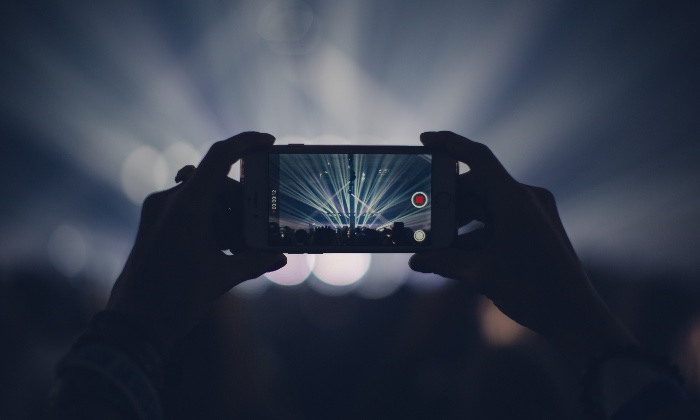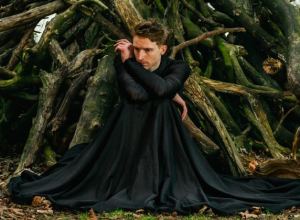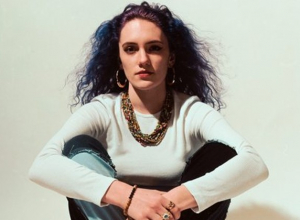How To Create Social Media Video Content That Stands Out
By Lenny Barksdale in Music / Festivals on 06 June 2022
Shooting gigs can be a great social media enterprise.
The world of social media keeps expanding. People want to see a different kind of content than they used to. Video content has taken the lead, and many individuals and brands alike invest heavily into this.
There is no denying that social media continues to be a vital aspect of people’s lives and an effective tool for businesses to raise awareness. The desired content keeps evolving and changing its style and direction, and creativity is the critical aspect that differentiates one brand from another and helps some people stand out. If you’re not thinking outside the box and embracing trends, you risk getting lost in a “sea” of social media profiles.
 Image credit: Unsplash
Image credit: Unsplash
For this reason, it is of the utmost importance to hone your creative skills when it comes to creating engaging, relevant and appealing content for social media, whether it is for personal or professional purposes. To truly stand out, being creative and having a strategy help you win the race in this entirely-digital era overwhelmed with information and content.
But what type of content is most relevant nowadays? Videos have more power than simple photographs. As much as 92% of digital marketers have stated that video content is a tremendous part of a marketing campaign, building their strategies on this. Compared to how things looked a few years ago when not many marketers believed videos were an effective strategy – in 2015, the need for video content was low – nowadays, 87% of marketing specialists point out that videos generate high ROI.
This giant leap, from video content being dismissed by the public to it surpassing visual content like photographs when it comes to how efficient it is, is mainly due to creators having a better understanding of how to make videos that catch the viewer’s attention. At the same time, consumers have changed their habits and preferences and wish to see short videos rather than scrolling through a photo album. Simply looking at the success of Insta-stories or reels and analyzing the thriving rise of TikTok, there is no denying that video content for social media is here to stay for a long time.
But how do you create captivating video content? What is the recipe for successful video content? In addition to being relevant and creating something that aligns with your target audience, there are some things you need to consider if you want to develop and generate engaging and striking videos on social media. They are as follows:
Consider The Length: Short Means Captivating
The vast majority of videos on social media that are most successful aren’t more than a couple of minutes. In fact, the most effective ones are those up to one minute or the 15-second reel or story. Indeed, if you want to convey a message that is more complex or record a podcast, the length of the video will have to be up to half an hour.
So, depending on the type of content you create, the length will have to match accordingly. If the content is relevant and of interest to your target audience, the result will be engaging.
But, as a rule of thumb, keeping video content short on social media is the key to catching people’s attention, especially individuals who are just discovering you – or the brand.
Background Music Adds Flavor and Makes It Stick
Music in a video is like salt in any recipe. It is the key ingredient that adds flavor and brings all the other elements together in a cohesive manner so that the end result effectively expresses the video’s message. For this reason, you should aim to add background music that aligns with the content itself. By doing this, you will have more chances of making this message stick with the audience, gathering viewings, and increasing engagement.
An essential and noteworthy mention would be to be very careful with the music you choose if you decide – and you should – to use music in your videos. Some songs may not be utilized due to copyright issues. For this reason, experts from MelodyLoops point out that you should download royalty-free background music for your video content. This way, you won’t have to worry about your videos having no music.
Through Storytelling, You Create a Personal Connection
If you look at music videos, they are always focused on storytelling, which is why there are so many of them regarded as captivating, making people remember the song better. Taking this from the music video creation process, you can apply it to the video content you create for social media.
You can grab your audience’s attention in the first few seconds, as it is highly recommended. However, to keep them interested, even if the video lasts for less than a minute, it is necessary to have a well-expressed, well-established story and a detailed message. Good storytelling is relevant, but it also has added value, eye-catching shots and wit.
Use High-Quality Filming Equipment and Editing Tools
Nowadays, with how effective video content has proved to be, many individuals, large organizations and brands are creating their own videos, taking into consideration their brands’ images and identities. For this reason, if you want to create appealing and engaging content, it is crucial to have high-quality filming equipment and use professional video editing tools.
Indeed, nowadays, you can do a lot with these last-generation smartphones. And when it comes to personal video content or creating reels, you can rely on the recording capabilities of a smartphone. But in case you want to record a detailed, lengthier video, it may be necessary to invest in more professional cameras.
Adapt And Optimize the Content for Each Social Media Platform Used
Given how many social media platforms there are, it is crucial to have an online presence on as many of them, provided they are relevant to you or the business and your target audience is on them. When it comes to the content, especially the video content you create, it is of the utmost importance to adapt it and optimize it for each individual platform.
This means that each social media platform or networking site has a different set of requirements when it comes to dimension, length limit and other such characteristics. For this reason, the same video content must be optimized to fall between each platform’s features.
Contactmusic
Suggested

Leisure Festival - Dreamland in Margate
On the same day that Glastonbury welcomed back Margate's adopted sons, The Libertines, Margate itself put on it's very own Leisure Festival as it...

Pretty Fierce talk to us about collaborating with Doja Cat, emetophobia, arena tours and staying "true to yourself" [EXCLUSIVE]
Sheffield's very own all girl group Pretty Fierce are still on a high after the recent release of their debut single - 'Ready For Me'.

Will Varley & Jack Valero - The Astor Theatre Deal Live Review
Three nights before the end of his current tour Will Varley returned to his home town of Deal to delight a sold out crowd in The Astor Theatre.

WYSE talks to us about her "form of synaesthesia", collaborating with Radiohead's Thom York and the prospect of touring with a band [EXCLUSIVE]
With only a few days to go before Portsmouth based songstress and producer WYSE releases her new single, 'Belladonna', we caught up with her to find...
Advertisement

Bay Bryan talks to us about being a "wee queer ginger", singing with Laura Marling and being inspired by Matilda [EXCLUSIVE]
Colorado raised, Glasgow educated and Manchester based Bay Bryan is nothing if not a multi-talented, multi-faceted artist performing as both...

Keelan X talks to us about staying true to "your creative vision", collaborating with Giorgio Moroder and being "a yoga nut" [EXCLUSIVE]
Former Marigolds band member Keelan Cunningham has rediscovered his love of music with his new solo project Keelan X.
![Luke De-Sciscio talks to us about having the courage to be yourself, forgiving that which is outside of one's control and following whims [EXCLUSIVE] Luke De-Sciscio talks to us about having the courage to be yourself, forgiving that which is outside of one's control and following whims [EXCLUSIVE]](https://images.contactmusic.com/images/home/homepage/luke-de-sciscio-abof-a.jpg)
Luke De-Sciscio talks to us about having the courage to be yourself, forgiving that which is outside of one's control and following whims [EXCLUSIVE]
Wiltshire singer-songwriter Luke De Sciscio, formally known as Folk Boy, is set to release is latest album - 'The Banquet' via AntiFragile Music on...

Annie Elise talks to us about the challenges a female producer has to face and "going through a year of grief and sickness" [EXCLUSIVE]
Electronic music pioneer and producer Annie Elise says that the release of her first EP - 'Breathe In, Breathe Out' feels "both vulnerable and...
Advertisement
